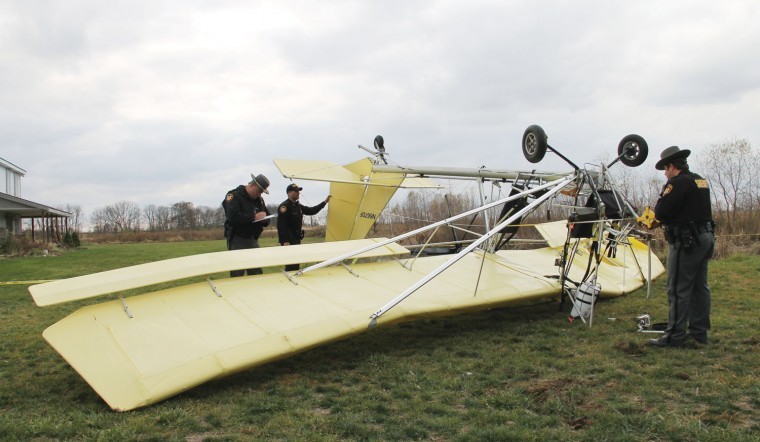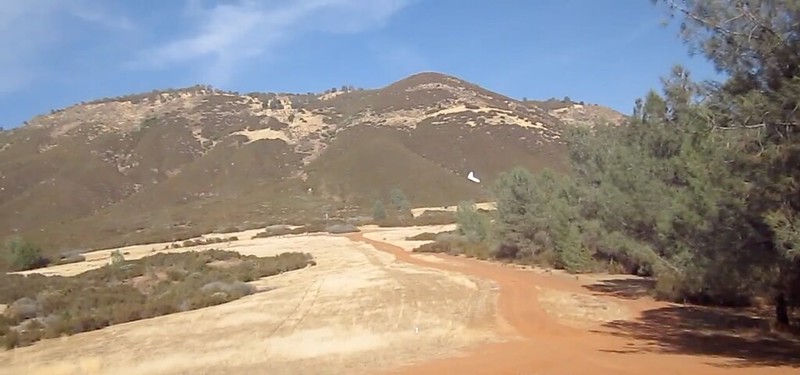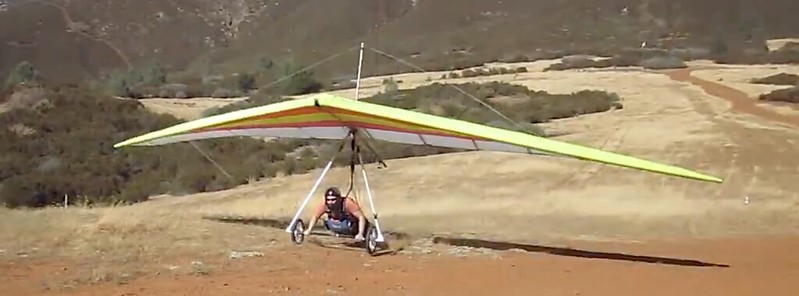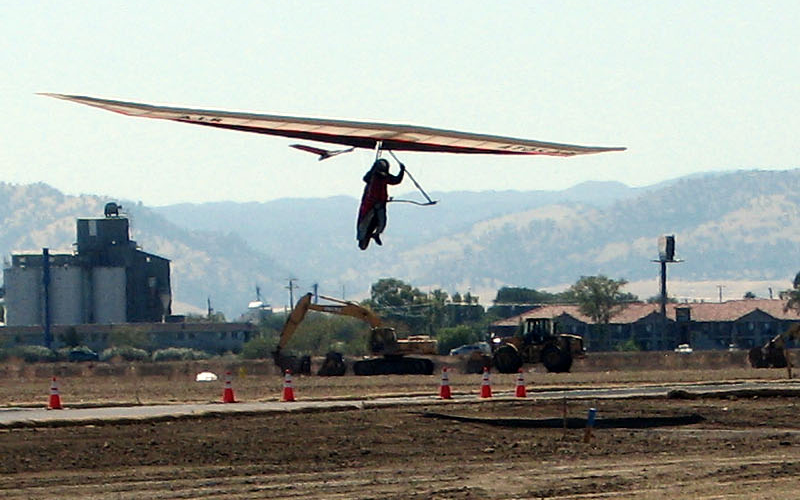Drogue Chute - Near Disaster At Kagel LZ
Jeff Chipman?NMERider - 2008/11/15 05:49:26 UTC
I recently heard about this incident first hand when riding up the Kagel just after the fires. Guess who?
http://ozreport.com/forum/viewtopic.php?t=24846Jeff Chipman - 2008/11/16 04:49:45 UTC
Sylmar
I know the glider and pilot
Unmistakable glider. If he would have pounded in he wouldn't be too far from where he lives.
Glad to see he was OK. Wonder why the glider dove the way it did?
Is this a joke ?
Jim Rooney - 2011/09/02 23:09:12 UTC
Yeah, damn those pesky safety devices!
Remember kids, always blame the equipment.
Maybe it's a really crappy idea to be taking hands off of basetubes during critical phases of flight. Just a thought.Allen Binder - 2008/11/16 08:05:11 UTC
El Segundo & Sylmar
Looks like the glider did a right turn. Maybe the chute was deployed with the left hand and the person mistakenly pulled in with the right hand without realizing it.
Just a thought.
Jesse Benson - 2008/11/16 21:40:39 UTC
I think the deployment just stalled the glider.
The wind gradient must have been a major factor. Because of the hillside, the gradient rose up to meet him as he deployed. Bad timing.
The rising terrain may also make the dive appear more severe than it was.
How 'bout now? More believable maybe?Don Banas - 2008/11/18 22:41:54 UTC
That loss of altitude immediately upon deployment was unbelievable.
This one ain't rocket science, Don.Once he came out of the turn and back onto the base leg the chute appears to drag off the ground a couple of times.
Maybe someone that has a lot of experience with chutes can help explain what/why what happened.
And, speaking of drag chutes:NMERider - 2008/11/19 00:04:22 UTC
There's a fair amount of discussion here:
http://ozreport.com/forum/viewtopic.php?t=13989
drogue chute lesson
including some of our very own members.
http://www.hanggliding.org/viewtopic.php?t=30722
What happened to JD?
Look at the video closely. Ask yourself just how much danger there was of him overshooting the LZ.Sebastian Lutges - 2008/11/19 07:12:26 UTC
Newhall
Look at the video closely. The chute snags a bush first, deflates a little then scrapes the ground.
Oh BULL SHIT!Joe Greblo - 2008/11/19 17:30:28 UTC
It's really quite simple. The pilot was flying at a high angle of attack (near stall angle) when he deployed his drag chute. What happens next is exactly what the drag chute is designed to do; steepen the flight path. But the moment the flight path steepens, the direction of the relative wind is now coming up at a steeper angle also; thus the stall. Remember, angle of attack is the angle of the airflow to the chord line. If either the airflow direction (relative wind) or the chord line direction changes, then the angle of attack changes. The glider's not smart enough to know if the pilot pushed the nose up, or if the direction of the relative wind has changed. In the case of the video, it was the latter.
A similar event occurs when a weak link breaks when towing at high angles of attack...
http://www.hanggliding.org/viewtopic.php?t=11497
Aerotow release options?
Sorry... but if you suddenly lose power, your nose just doesn't pop.Jack Axaopoulos - 2009/07/04 12:13:01 UTC
Bullshit.
a) only the pilot can let the angle of attack increase when you lose tension. Thats 100% on the pilot. You are simply wrong and misleading again.
b) "And if your angle of attack was way too high to begin with..." Which should never be the case or youre making a pilot error. Again, you are misleading people.
This is the problem I have with you. You attempt to fallaciously attribute pilot errors to issues of mechanical towing devices or other things.
Sorry... but if you suddenly lose power, your nose just doesnt pop
You mean like THIS?:...or an ultralight's engine failure during a steep climb out after take-off.

So you're saying that the effect of a weak link failure on a hang glider is identical to the effect of an engine failure on a tug - even though...
http://ozreport.com/forum/viewtopic.php?t=24846
Is this a joke ?
...the purpose of a weak link is to increase the safety of the towing operation - PERIOD?Jim Rooney - 2011/08/26 02:44:10 UTC
The "purpose" of a weaklink is to increase the safety of the towing operation. PERIOD.
http://www.ushawks.org/forum/viewtopic.php?f=15&t=884
The Bob Show
http://www.ushawks.org/forum/viewtopic.php?f=23&t=811Bob Kuczewski - 2011/12/13 05:55:39 UTC
I've had to deal with your profanity, your attacks on other members, your strong weak link theories, your lift and tug theories, and your hopelessly long and repetitive posts.
FTHI
Fuck you, Bob.Bob Kuczewski - 2011/10/25 06:28:43 UTC
Joe knows far more about hang gliding than I probably ever will.
Not on a weak link break...The glider's trajectory suddenly changes from an ascent to a descent. This significant change in flight direction creates a sudden change in the angel of attack, often resulting in a deep stall.
http://ozreport.com/forum/viewtopic.php?t=24846
Is this a joke ?
A weak link break improves safety. Say it over and over and over in your head until it sinks in. Why do you think they refer to it as the angel of attack? The bigger the better, dude.Jim Rooney - 2011/08/26 17:34:33 UTC
Remember, a weak link improves safety.
Say it over and over and over in your head until it sinks in.
1. How 'bout deploying a weak link near the terrain?The message is simple. Don't deploy a drag chute near the terrain at a high angle of attack.
Surely that couldn't be dangerous. You'd probably be locking out with your release within easy reach and that would be your only hope of survival.The United States Hang Gliding and Paragliding Association, Inc. - 2013/02/07
Standard Operating Procedure
12. Rating System
02. Pilot Proficiency System
12. Hang Gliding Aerotow
-A. Aerotow
05. The candidate must also demonstrate the ability to properly react to a weak link/tow rope break simulation with a tandem rated pilot, initiated by the tandem pilot at altitude, but at a lower than normal release altitude. Such demonstrations should be made in smooth air.
2. Is there some message for going up behind some total fucking asshole...
http://www.chgpa.org/forums/viewtopic.php?f=2&t=2467
weak links
...who's primed to fix whatever's going on back there by giving you the rope?Jim Rooney - 2007/08/01 13:47:23 UTC
Whatever's going on back there, I can fix it by giving you the rope.
But it's OK when a locked out pilot releases just one of his hands in order to deploy the release?Pulling the nose down just before deploying the drag chute can also cause problems. The bar pressures associated with faster flight can cause a serious turn when the pilot releases just one of the hands in order to deploy the chute.
Hey Joe...
- When is it gonna be most critical for towed glider to release?
- What's: almost certainly gonna:
-- be going on with bar pressure at that time?
-- happen:
--- if/when the pilot releases just one of the hands in order to deploy the release within easy reach?
--- right after the weak link increases the safety of the towing operation?
- Where the fuck were you during the Zack Marzec postmortem discussions - or any of the other standard aerotow weak link flame wars?
How 'bout we train pilots how to approach to get onto final so low that the goddam glide slope doesn't matter.I have dozens of landings with drogue chutes and find them a viable tool to remedy one of the modern hang glider's most serious flaws (the inability of the pilot to control his glide slope without significantly changing airspeed).
There are dangers with drag chutes as well...
1. And you obviously agree completely with Rob McKenzie's post on The Jack Show advising everyone to totally fucking ignore USHGA's hook-in check regulation....so no one should attempt to use one without careful preparation and training. I agree completely with Rob McKenzie's post on the Oz Report Forum regarding when to deploy the drag chute; essentially well before entering any segment of the approach.
2. So what fields requiring drag chutes are you and Rob recommending people land in?
What? Fatality reports for people like Gerry Smith, Mike Haas, Jeremiah Thompson, Arlan Birkett weren't impressive enough for you?Frederick Wagner - 2008/11/20 19:09:11 UTC
Mar Vista
Stall
Now, it seems like that's a great video of how much altitude loss there is with a stall and recovery -- something I hadn't a great sense for before.
How 'bout this one?:
http://www.youtube.com/watch?v=WFAPpz6I6WU
http://www.hanggliding.org/viewtopic.php?t=14312Sure glad he made it. I don't want to do any more memorial services.
Tow Park accidents
Jack Axaopoulos - 2009/11/12 14:49:58 UTC
One of the stated goals of this site is to promote HG. MOST views on this site are NOT from members but from visitors, they have no ignore button.
Having Tad run around every day giving the impression that there is a massive weekly slaughter of pilots at tow parks due to their horribly dangerous devices surely doesnt promote HG. Especially when the safety records are quite excellent.
Like Jim said, theyve gone a decade with no fatalities at their tow park. Pretty damn good I say.
Yet listening to Tad, you would think guys were dying all over the place
He's been nothing but misleading and negative and ignored multiple warnings from me. So He's GONE
Yes. Chances are he won't be in any shape to experience it though.Eric Brown - 2008/11/20 22:29:40 UTC
Los Angeles
I was thinking the same thing Freddy. I wonder, if he had done this at half the altitude and found himself in a stall recovery headed straight for the ground is there any exit from that?
Why are you asking this? Are you planning on getting into situations in which you can test various ideas?Is it possible to flare going uphill/downwind when in a deep stall like that? Does it depend on which part of the stall you're in?
That's alright. There'll be plenty enough energy to do other stuff. And the glider will stop on a dime with no risk whatsoever of overshooting the field.Malury Silberman - 2008/11/22 05:40:30 UTC
Alhambra
WOW! That's scary. I think a stall is a stall is a stall and there is just not enough energy in the glider to flare.
Even so, after pulling in for recovery, I would flare it as hard as possible before impact. What else can you do? Land fast dude.





